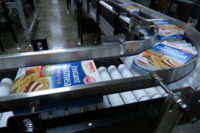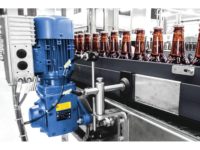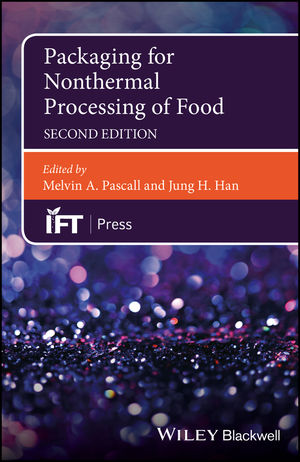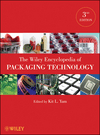Web Exclusive
Assessing conveying systems for streamlined throughput in high-volume coffee roasting
The latest generation of tubular drag cable conveyors provide critical process and product quality benefits.

Transforming raw, green coffee beans into a tantalizing, aromatic light cinnamon roast or a fragrant, robust dark roast is the art and science of coffee roasting. To achieve the desired flavor and blend, coffee roasters utilize a combination of skill and technology.
Combining learned roasting skills with the ever-evolving technology of roasting equipment is part of the challenge of refining roasting processing skills for the ideal efficiencies of an operation. Just as there are trade-offs and considerations between different roasting processes, there are similar considerations between conveying systems.
The variety of equipment for conveying coffee has evolved from augers to buckets to air and drag systems. The reasons for this evolution are typical – cost considerations come first and then through improved knowledge, up-front cost becomes a lesser factor as specialty coffee and more valuable materials, combined with environment control and process efficiency, command the attention of the roaster needing to convey beans with less damage.
To be clear, less damage equals control. Controlling roasting processes is key to growth. A roaster cannot grow well if it does not have a first-hand understanding of its processes, and how to improve them. Implementation of a better conveyor system occurs when efficiency and control trumps all other considerations.
Despite using the best processing equipment to roast and package the coffee, if the material handling systems being used for moving the coffee beans into and out of the equipment is inefficient, then the quality of the coffee and the throughput volume will be compromised. For example, some conveying systems are more prone to bean breakage than others. Cost is a factor here – some roasters, upgrading from a manual operation, may initially implement a less efficient conveyor system, one that has a higher level of bean breakage, simple because the entry cost is more affordable. Speed can also be a factor. Some high-velocity conveyor systems can move whole beans rapidly, but also have a high incidence of bean breakage in the process. In this wise, coffee roasters may be using conveying equipment that is not ideally suited to address the needs of their coffee roasting and packaging applications.
Challenges of conveying coffee
Coffee roasters are beset with several critical conveying challenges. One of the most important is ensuring that the finished coffee product, once it has gone through its various roasting process steps, emerges undamaged before its final packaging. Keeping the beans whole can be a challenge. The idea is to get the beans through the roasting process and into the packaging as gently as possible to avoid product breakage.
Coffee roasters know that how their product is conveyed during the entire roasting process plays an important role in ensuring minimum waste as raw goods are transformed into finished coffee products ready for packaging.
Conveying equipment is designed to optimize the movement of roasted beans, and to maintain the optimal grind level that is determined appropriate for roasters’ customers. This optimization is as good as a roaster’s decision-making process. In other words, a roaster’s relationship with its customers, and their communication about their needs, will impact that roaster’s decisions.
“When selecting a conveyor, roasters should look at how the coffee is being treated by that conveying system,” says Paul Massard with The Roasterie Air-Roasted Coffee, in Kansas City, MO. “You do not want anything that is going to break the coffee beans, or physically harm the coffee. It should be a gentle conveying system. Depending on the type of coffee being used, sometimes the conveyor system has to be cleaned for dust to minimize contamination, or even a fire.”
A roasting company does not want a random breakage rate of its whole bean or decaf coffee. But until testing is done, the roaster will not know for sure what percentage of breakage it is experiencing.
This is where the challenge lies – testing a roaster’s processes to determine which conveying machines work best for its environment. To make an informed decision, the roaster needs to determine relevant criteria. Is 10% breakage acceptable? What does this breakage equal in dollars? A roaster conveying three million pounds annually with 10% breakage would have 300,000 pounds of broken beans. Does breakage, for that roaster, mean waste, or is the broken whole bean reclaimed and ground to specification for coffee offered as ‘ground’? Are a roaster’s internal processes defined well enough to reclaim broken material? Determining where each roaster stands on this spectrum is an important step towards understanding what conveying equipment will serve best.
“Our entire coffee processing area was modernized in the fourth quarter of 2010,” explains Vinny Tagliaferro, plant manager, coffee operations, Melitta, USA headquartered in Clearwater, FL. “Factors critical to us in the selection of conveyors were: a) protecting the quality of the coffee – minimizing breakage for roasted whole bean products; b) food safety and organic production requirements – self-cleaning and leaving little residual coffee in the conveying system, for faster changeovers and minimized flush out requirements for blend changes; c) personal safety – obviously all conveyor systems have to have proper safety devices; and e) ease of maintenance – easy access to areas requiring preventive maintenance.”
Product contamination is another key issue influencing conveying in coffee roasting. In every step of the process, from receipt of raw beans through packaging, precluding any foreign matter from entering the process stream is a critical objective. Bucket elevators and belt conveyors, which have an open profile, not only permit the entry of coffee dust and foreign particles into the work-in-progress coffee production, but they promulgate and spread dust because of their exposed format.
This opens the door to contamination and unwanted spread of allergens. The importance of the product contamination issue is magnified with increasingly stringent governmental and industry mandates, and consumer demands for maintaining product integrity and safety.
City, state, national and international standards for cleanliness, dust-explosion prevention and Good Manufacturing Practices (GMP) vary widely. Roasting standards should align, at a minimum, with a roaster’s local laws and guidelines.
Line changeovers in coffee roasting are also a factor influencing both cleanliness and speed. Roasting companies run different product lines within a shift or day. Despite these changeovers, processing plants are expected to maintain stringent levels of sanitary operation. This can be a time-consuming challenge when cleaning conveying systems.
Bucket elevators and belt conveyors are particularly notorious for requiring significant time for cleaning because of their various interlocking components. Every minute spent disassembling a conveyor system for cleaning consumes valuable production time. Yet, if not cleaned properly, that batch of coffee that needs to be discarded in-process because of contamination is lost profit. Or worse, consumers could be negatively impacted, resulting in potential injury, costly recalls and reduced brand reputation. To resolve these issues, coffee roasters are charged with administering changeovers as quickly as possible while maintaining 100 percent system cleanliness.
Traditional systems for conveying coffee
For decades, open conveyors, such as flat-belt conveyors and bucket elevators, have been the predominant systems used by coffee roasters to transport coffee beans through the roasting process to packaging. But, because of the limitations of these open conveying systems, coffee roasters have gradually moved to utilizing other conveyor types, dominated by closed-system tube conveyors. Like the open conveyors, they each have design strengths and weaknesses. Following is an assessment of the major types of systems being employed in coffee bean roasting:
Flat-Belt Conveyors– Although this type of conveyor can handle coffee beans gently, the product is exposed to ambient contamination, unless covered. The cover, however, collects coffee residue and must be removed and cleaned between runs to reduce the risk of cross-contamination, a usually tedious task. The beans, when introduced onto the conveyor are dropped from a machine during the roasting process, which produces dust and at that point can cause product damage.
Bucket elevators– Bucket elevators use a continuous line of buckets, either attached to each other on a rubber belt, or attached by pins to two endless chains running over tracks and driven by sprockets. Centrifugal force throws the coffee beans out of the buckets into a discharge spout as the buckets pass. This type of conveyor can transport fragile materials with minimized product damage. But the system can be very dusty, as dust is generated when beans are loaded into the buckets and while the product is being conveyed, resulting in residue build-up which can cause cross-contamination. The excessive dust produced can also open the door for dust explosions.
Pneumatic conveyors– These systems use air to move coffee beans through the roasting process, by generating air pressure levels that are either above or below the atmospheric pressure. There are two main types of pneumatic conveyors: the dilute phase conveyor and the dense phase conveyor, which differ by rate of speed and pressure. Both of these systems can be set up as a pressure or vacuum system. Pneumatic conveyors enable flexibility, allowing them to reach many multiple destinations with one system. They are also able to convey beans at very high rates with minimal product breakage and dust dissemination (Dust is accumulated in filters). Coffee beans can endure breakage using this type of system depending on the sweeps and discharges. One of the main problems with pneumatic conveyors is their high power consumption. Pneumatic conveying is the most expensive method for moving coffee beans.
Auger conveyors– Known as flexible screw conveyors, they can transport coffee beans vertically, horizontally and at any angle. They consist of a stainless steel flexible screw enclosed in a rigid steel tube or flexible plastic tube driven by a motor. The enclosed tube rotates around a central shaft, transporting the coffee beans according to the screw design and rotational direction. When the beans reach the end of the tube they are discharged into the next machine in the roasting process, such as a grinder, or container for packaging. These conveyors have a throughput of up to 100,000 pounds per hour. Auger conveyors, however, have limitations on how much product they can transport before effecting product breakage, which can be significant. Also, internal cleanliness can be an issue resulting in a cross-contamination risk, with the need to disassemble the unit on a regular basis for cleaning.
Aeromechanical conveyors– A completely enclosed, high-capacity mechanical conveyor that can move coffee beans vertically, horizontally and at varying angles. Within a stainless-steel tube, a wire rope with evenly spaced discs travels at high speeds, running in sprockets at each end of the conveyor. The high-speed action generates an internal air stream traveling at the same high velocity as the discs. As the coffee beans are fed in, the air stream aerates, or fluidizes them, and carries the product to the next machine in the roasting process, or packaging outlet, where the beans are discharged by centrifugal force. The system can move up to 80,000 pounds per hour of beans. A drawback to this system is that the flow of product can easily become inhibited, causing the conveyor to run without transporting beans at expected throughput volumes. Downtime is also a factor because the tension on the wire rope needs to be adjusted at regular intervals.
Tubular drag chain conveyors– This conveyor gently moves coffee beans through a sealed tube with a drag chain pulled through it on a loop. Solid circular discs (flights) are attached to the chain, which push the beans through the tube. This system can move up to 45,000 pounds per hour throughput of coffee beans. One of the drawbacks to this system is the tendency of the chain to accumulate coffee debris build-up, which poses a cross-contamination risk.
Tubular drag cable conveyors – a more efficient lean-process conveying solution
Tubular drag cable conveyors are fast becoming the system of choice for product movement through the coffee roasting process. The system gently moves whole beans and ground coffee through an enclosed tube without the use of air. This latest generation of tubular drag cable conveyors can transport up to 49,000 pounds of coffee beans per hour, at low speed, and with product degradation practically eliminated.
Similar to tubular drag chain conveyors, tubular drag cable conveyors gently move product through a sealed tube, but instead use a patented, coated, flexible stainless steel drag cable pulled through on a loop. Solid circular discs (flights) are attached to the cable, which push the beans through the tube. The coated cable ensures that no debris accumulates within the strands of the cable, as the cable is totally sealed.
Designed for quick cleaning, quick line changeovers and maximized system uptime, the tubular drag cable conveyor system employs sophisticated cleaning mechanisms to reduce coffee debris build-up. The flexible design of this completely enclosed system keeps contamination out, while enabling it to be cleaned-in-place at multiple points from coffee build-up. For example, an air knife at the product discharge locations in the system automatically releases food particles from the discs and cable. Also, urethane wiper discs attached to the cable eliminate any coffee residual debris from the conveyor system while in progress.
To increase uptime, the system is equipped with a cable self-tensioning device, as different from other conveying methods which require continual adjustments to their mechanical operating systems.
The tubular drag cable conveyor operates on low horsepower, utilizing energy-efficient variable-speed motors of up to 5 HP each, effectively consuming minimal power compared to other conveyor systems utilized in coffee roasting. The system’s production flow can be adjusted to variable speeds.
This conveyor system has the unique flexibility to integrate with any processes in coffee roasting: from receipt of raw beans, to and from the roaster, to flavoring, to weight and fill, grinding and packaging. They are critically applicable where beans can become damaged, where contamination would be prevalent, or where dust accumulation can be excessive, such as in filling and packaging.
Keeping up with roasters’ needs
Traditional conveying systems have minimally kept pace with the challenging requirements for high quality that coffee roasters face. Additionally, high-volume roasters continually push for more cost efficiency and higher throughput in their processing lines, which are also driving the need for system upgrades in coffee processing worldwide.
Conveying systems that were installed in coffee roasting facilities 10 to 15 years ago may have been adequate at that time, but now better technology in conveying system design, controls and automation has brought into place a whole new generation of conveyors for use in the coffee industry, with resultant vastly improved efficiency. Safer, cleaner processes that reduce waste and deliver cost, labor and energy savings are increasingly being factored into equipment selection. Such next-generation conveying systems are having a critical impact on coffee roasters’ operational costs and plant ROI.
About CableveyConveyors
Cablevey Conveyors (www.cablevey.com), a division of Intraco, Inc., is the leading manufacturer of tubular drag cable conveyors and material handling systems for whole bean coffee, pistachios, almonds and peanuts, cereal, beans, seed, snacks and powder and bulk solids.
“This story was originally published in September 2013 Roast magazine.”
Looking for a reprint of this article?
From high-res PDFs to custom plaques, order your copy today!









